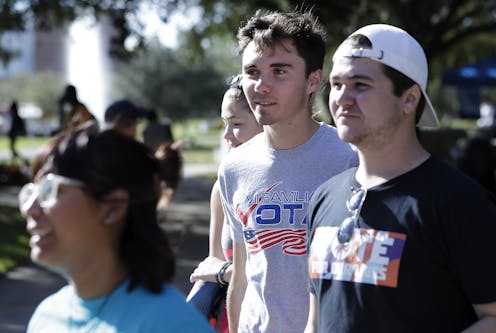The other 2018 midterm wave: A historic 10-point jump in turnout among young people
A survey shows the newest generation on the voting block is extremely cynical, and that drove record numbers of them out to vote.

Voter turnout among 18 to 29-year-olds in the 2018 midterm elections was 31 percent, according to a preliminary estimate by The Center for Information and Research on Civic Learning and Engagement at Tufts University.
That’s the highest youth turnout my colleagues and I have observed since we started collecting data in 1994. It’s also a major increase from turnout in the 2014 midterms, which was 21 percent.
Young people showed decisive support for liberal candidates and ideas. About 67 percent of young people supported Democratic House candidates, compared to just 32 percent for Republican candidates. This 35-point gap is even larger than their preference toward Democrats in 2008, when President Barack Obama was first elected.
This preference no doubt helped some Democratic candidates in states such as Wisconsin, Montana and Nevada.
For example, Senator Jon Tester of Montana won his reelection by a narrow margin of less than 6,000 votes. Young Montanans, by favoring him by 67 percent to 28 percent, gave him a relative vote advantage of over 25,000 votes. If young Montanans voted like older Montanans did on Tuesday, Montana would have a Republican Senator today.
In many ways, this election cycle showed how different groups can create diverse paths to political engagement. It shows in the numbers, and importantly, in young people’s faces. Young people should be feeling powerful and hopeful that they can in fact exercise their votes to affect American politics.
Going back 40 years, young voters have a reputation of not showing up to the polls, especially in midterm elections. So how do we explain this year’s enthusiasm?
This fall, my colleagues and I conducted two large-scale national surveys of 2,087 Americans ages 18 to 24 to document and understand what Gen Zs are thinking, feeling and doing when it comes to politics.
Here’s what we found.
All signs pointed to wave of young people
The proportion of young people who joined protests and marches tripled since the fall of 2016, from 5 percent to 15 percent. Participation was especially high among young people who are registered as Democrats.
We also found that young people were paying attention to politics more than they had in 2016. In 2016, about 26 percent of young people said they were paying at least some attention to the November elections. This fall, the proportion of youth who reported that they were paying attention to the midterm races rose to 46 percent.
It’s clear that more young people were actively engaged in politics this year than 2016.
Why?
Cynicism and worry aren’t obstacles
To learn more about what might was motivating Generation Z to vote, we asked survey participants to rate their level of agreement with three statements.
“I worry that older generations haven’t thought about young people’s future.”
“I’m more cynical about politics than I was 2 years ago.”
“The outcomes of the 2018 elections will make a significant impact to everyday issues involving the government in my community, such as schools and police.”
In this year’s survey, we found that young people who felt cynical were far more likely to say they would vote. Other research has found that cynicism about politics can suppress or drive electoral engagement depending on the contexts.
Among young people who said “yes” to all three of those questions, more than half – 52 percent – said they were extremely likely to vote. Among young people who said “no” to all three of those questions, only 22 percent were extremely likely to vote.
Our poll results suggest political involvement in this generation is far above the levels we usually see among youth, especially in midterm election cycles.
In fact, almost 3 out of 4 youth – 72 percent – said they believe that dramatic change could occur in this country if people banded together.
This year’s voting surge by young people did not happen overnight. Nor was it driven by a single issue like gun violence, though Parkland no doubt played a very important role by activating many young people and voter engagement groups.
Our research shows that Gen Z is aware of the challenges ahead and they are hopeful and actively involving themselves and friends in politics. Beyond almost any doubt, young people have gotten involved and felt ready to make a change in American politics – and so they did.
Kei Kawashima-Ginsberg receives non-partisan research funding from Ford Foundation, Democracy Fund, and McCormick Foundation she is affiliated with Democracy Fund, TurboVote Challenge, Nonprofit VOTE and Generation Citizen. She is not paid by any of these organizations.
Read These Next
As DOJ begins to release Epstein files, his many victims deserve more attention than the powerful me
Powerful men connected to Jeffrey Epstein are named, dissected and speculated about. The survivors,…
How to reduce gift-giving stress with your kids – a child psychologist’s tips for making magic and a
Depending on family circumstances and a child’s personality type, gift giving runs the gamut of fun…
The world risks forgetting one of humanity’s greatest triumphs as polio nears global eradication − 7
Polio may finally be defeated in the next 5 years. Will the world recognize what an extraordinary achievement…






